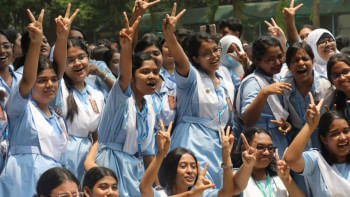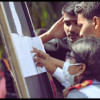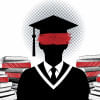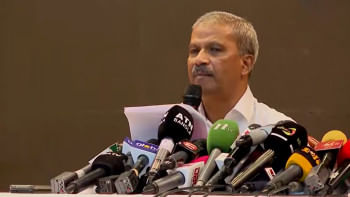The HSC result debacle exposes long-hidden cracks in our education

For two decades, Bangladesh lived under a comforting numerical, statistical, and sweetly deceptive illusion. Year after year, Higher Secondary Certificate (HSC) results painted a glowing picture of academic progress. Pass rates soared above 80 percent, GPA-5s multiplied, and education officials celebrated success as if knowledge itself had bloomed in every classroom. Yet, beneath those glossy percentages lay an unspoken truth that has finally emerged in 2025. The latest HSC results, with a pass rate of 58.83 percent, the lowest in 21 years, have jolted the nation awake. More than half a million students failed. The numbers that once flattered now frighten, revealing a system that mistook certification for learning.
For years, a high pass rate had become a proxy for progress, while inflated marks and liberal "sympathy grading" turned mediocrity into merit. In 2005, the average pass rate stood at 59.16 percent. Within a year, it climbed past 60 percent, never to fall below that mark until now. In the years following the pandemic, it even touched a surreal 100 percent due to automatic promotions and relaxed evaluations. The country basked in statistical glory while its classrooms quietly crumbled. Teachers marked papers generously, grace marks were liberally distributed, and results became an instrument of political self-congratulation. In a society obsessed with numbers, no one dared to ask what those numbers truly meant.
This year's results puncture that illusion. Only 69,097 students achieved GPA-5s, compared to nearly 150,000 the previous year. In 202 educational institutions, not a single student passed. Board-wise, the Dhaka Board fared best with 64.62 percent, while Cumilla languished at the bottom with 48.86 percent. The failure rates in key subjects such as English and ICT dragged down the overall average, revealing deep-rooted weaknesses in core competencies that years of statistical inflation had concealed.
The immediate reaction has been one of disbelief. Parents are devastated, students are confused, and educational authorities are defensive. But the truth is simple: the results are not worse; they are merely real. The reasons behind this collapse are neither sudden nor mysterious. The foundation of Bangladesh's education system has long been fragile. The crisis begins at the primary level, where rote memorisation substitutes for comprehension, and teaching quality varies wildly. The weaknesses accumulate through secondary education, only to manifest catastrophically at the higher secondary level. For years, the system managed to hide these cracks with inflated grading, often to meet political expectations. Now, stripped of those cushions, the cracks have widened into chasms.
Repeated policy changes have not helped. Every new government, every new education minister, has wanted to "reform" education—often through abrupt curricular shifts, experimental grading methods, or politically motivated targets. Instead of stability, the system has endured constant tinkering. Teachers have been left confused, students disengaged, and parents cynical. The introduction of creative question systems, multiple-choice reforms, and shifting assessment patterns came without adequate teacher training or infrastructure. It created an education that was neither traditional nor innovative, merely inconsistent.
Equally damaging has been the social environment in which this system operates. In a culture that prizes certificates over competence, students are conditioned to chase grades, not understanding. Coaching centres, guidebooks, and "shortcut" learning have replaced critical thinking. The rise of AI-based summarisers and digital "totka" (shortcut) lessons has only worsened this trend. Students now often know the pattern of the exam paper better than the subject itself. The classroom has become secondary to the coaching centre, and the teacher's role has shrunk to that of an invigilator in a race for scores.
The role of teachers in this crisis cannot be ignored. Many institutions suffer from an acute shortage of skilled and motivated educators. Underpaid, undertrained, and overburdened, teachers often struggle to maintain standards. The consequence is predictable: weak instruction breeds weaker comprehension, which in turn produces dismal outcomes. In rural areas, absenteeism, outdated methods, and inadequate monitoring compound the problem. When more than 200 institutions produce zero pass rates, it is not the fault of one examination but of a structure that has failed both its teachers and its students.
It would be easy to blame this year's stricter evaluation process or the discontinuation of grace marks for the sudden drop. But that argument ignores the deeper rot. A nation cannot inflate results indefinitely without eroding the very meaning of education. The 2025 results, therefore, should not be seen as a catastrophe but as a mirror. They reflect what has long been hidden: a generation that has been taught to pass exams, not to learn; to memorise answers, not to question ideas.
What this result exposes most painfully is the bankruptcy of the political narrative surrounding education. For years, governments have showcased rising pass rates as proof of national progress. Education became a performance metric in political speeches, not a genuine developmental priority. Budgets were announced with slogans, not strategies. Infrastructure projects were inaugurated, but pedagogy was neglected. When education is treated as propaganda, the outcome is inevitable: a nation that can produce certificates but not citizens.
There is also a moral dimension to this failure. When society measures a student's worth solely by grades, it perpetuates a toxic cycle of pressure and deception. Students learn that numbers matter more than knowledge, that success is statistical, not intellectual. Parents and institutions reinforce this illusion, until the system collapses under its own weight. The 2025 results are not the fall of education; they are its reckoning.
Yet, amid the despair, there lies a rare opportunity. This year's outcome can be the beginning of intellectual honesty in education. It invites policymakers to abandon the politics of pass rates and confront the reality of learning deficits. It challenges institutions to rebuild classroom integrity, not grade inflation. It compels teachers to reclaim their role as educators rather than result producers. And it urges parents to value curiosity over certificates.
To repair this system, Bangladesh must return to fundamentals. The obsession with examinations must give way to an emphasis on learning. Teacher training must become continuous and professional, not occasional and ceremonial. Curricula must foster analytical thinking instead of rote memorisation. Digital tools should enhance, not replace, understanding. Education policies must be evidence-based, stable, and shielded from political interference. Most importantly, society must redefine what it means to be "educated."
The HSC results of 2025, harsh as they appear, are not the end of the story. They are the beginning of truth-telling. For years, Bangladesh believed that it was doing well because the numbers said so. Now, the numbers say otherwise, and perhaps for the first time, they are telling the truth. The real challenge is whether the nation has the courage to listen.
H. M. Nazmul Alam is an academic, journalist, and political analyst based in Dhaka. Currently, he teaches at International University of Business Agriculture and Technology (IUBAT) and can be reached at [email protected].
Views expressed in this article are the author's own.
Follow The Daily Star Opinion on Facebook for the latest opinions, commentaries and analyses by experts and professionals. To contribute your article or letter to The Daily Star Opinion, see our guidelines for submission.

 For all latest news, follow The Daily Star's Google News channel.
For all latest news, follow The Daily Star's Google News channel. 











Comments